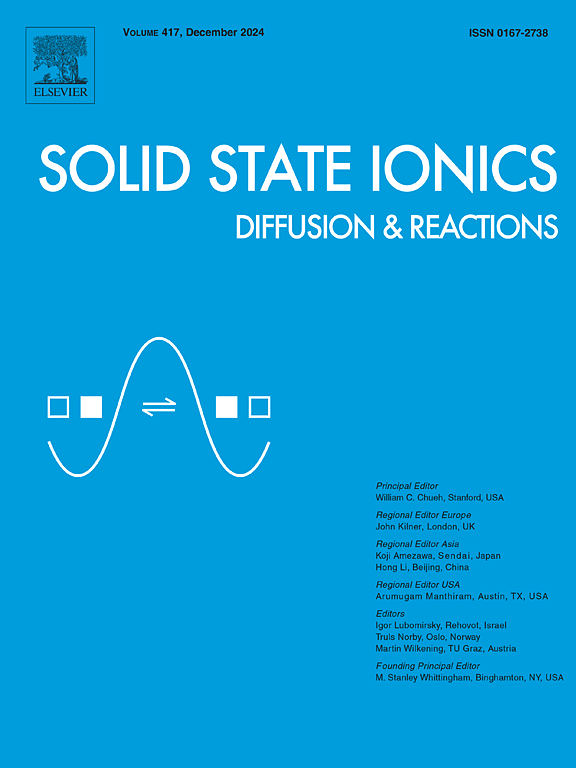Intrinsic limitation of conductivity in depolymerized sodium-ion glassy networks
IF 3.3
4区 材料科学
Q3 CHEMISTRY, PHYSICAL
引用次数: 0
Abstract
The electric properties of a model fast-ion electrolyte glass (100-)SiS – NaS are investigated by means of classical molecular dynamics simulations. These materials are promising candidates for battery applications and the conductivity is thought to be essentially driven by the concentration of Na charge carriers. We first set up a Buckingham-Coulomb type potential able to describe the atomic structure and experimental structure functions (structure factor) in an improved fashion with respect to previous reported force fields. A systematic investigation of properties with modifier content NaS (50 %80 %) leads to an unexpected result, that is, a near constant behavior of the conductivity with NaS increase for various isotherms in the liquid state. The analysis indicates that unlike Li-based electrolytes, the diffusivity ratio between network (Si,S) and modifier (Na) species is reduced, of about 6–8, and differs substantially with the corresponding lithium counterpart for which the same ratio is about 100. This leads to a contribution to conductivity dominated by (Si,S) atoms for the sodium system. While the concentration of network species in the range 66 %80 % decreases, no dramatic increase in Na diffusivity is obtained, and the emergence of molecular NaS in the structure at large modifier content also induces profound structural changes. Unlike Lithium glassy electrolytes, the design of Na-based batteries must, therefore, take into account the contribution of the network species.
解聚钠离子玻璃网络电导率的内在限制
采用经典分子动力学方法研究了快速离子电解质玻璃(100-x)SiS2 - xNa2S的电学性质。这些材料是电池应用的有希望的候选者,电导率被认为主要是由Na载流子的浓度驱动的。我们首先建立了一个白金汉-库仑型势,能够以一种改进的方式描述原子结构和实验结构函数(结构因子)。系统地研究了Na2S含量(50%≤x≤80%)时的性能,得到了一个意想不到的结果,即在不同的等温线下,随着Na2S的增加,电导率σx的行为接近恒定。分析表明,与锂基电解质不同,网络(Si,S)和改性剂(Na)之间的扩散系数比降低了约6-8,与相应的锂基电解质有很大差异,相同的比率约为100。这导致了钠系统中由(Si,S)原子主导的电导率的贡献。在66%≤x≤80%范围内,网状物质的浓度降低,但Na扩散系数没有显著增加,在改性剂含量较大时,结构中出现了分子Na2S,也引起了结构的深刻变化。因此,与锂玻璃电解质不同,钠基电池的设计必须考虑到网络物种的贡献。
本文章由计算机程序翻译,如有差异,请以英文原文为准。
求助全文
约1分钟内获得全文
求助全文
来源期刊

Solid State Ionics
物理-物理:凝聚态物理
CiteScore
6.10
自引率
3.10%
发文量
152
审稿时长
58 days
期刊介绍:
This interdisciplinary journal is devoted to the physics, chemistry and materials science of diffusion, mass transport, and reactivity of solids. The major part of each issue is devoted to articles on:
(i) physics and chemistry of defects in solids;
(ii) reactions in and on solids, e.g. intercalation, corrosion, oxidation, sintering;
(iii) ion transport measurements, mechanisms and theory;
(iv) solid state electrochemistry;
(v) ionically-electronically mixed conducting solids.
Related technological applications are also included, provided their characteristics are interpreted in terms of the basic solid state properties.
Review papers and relevant symposium proceedings are welcome.
 求助内容:
求助内容: 应助结果提醒方式:
应助结果提醒方式:


